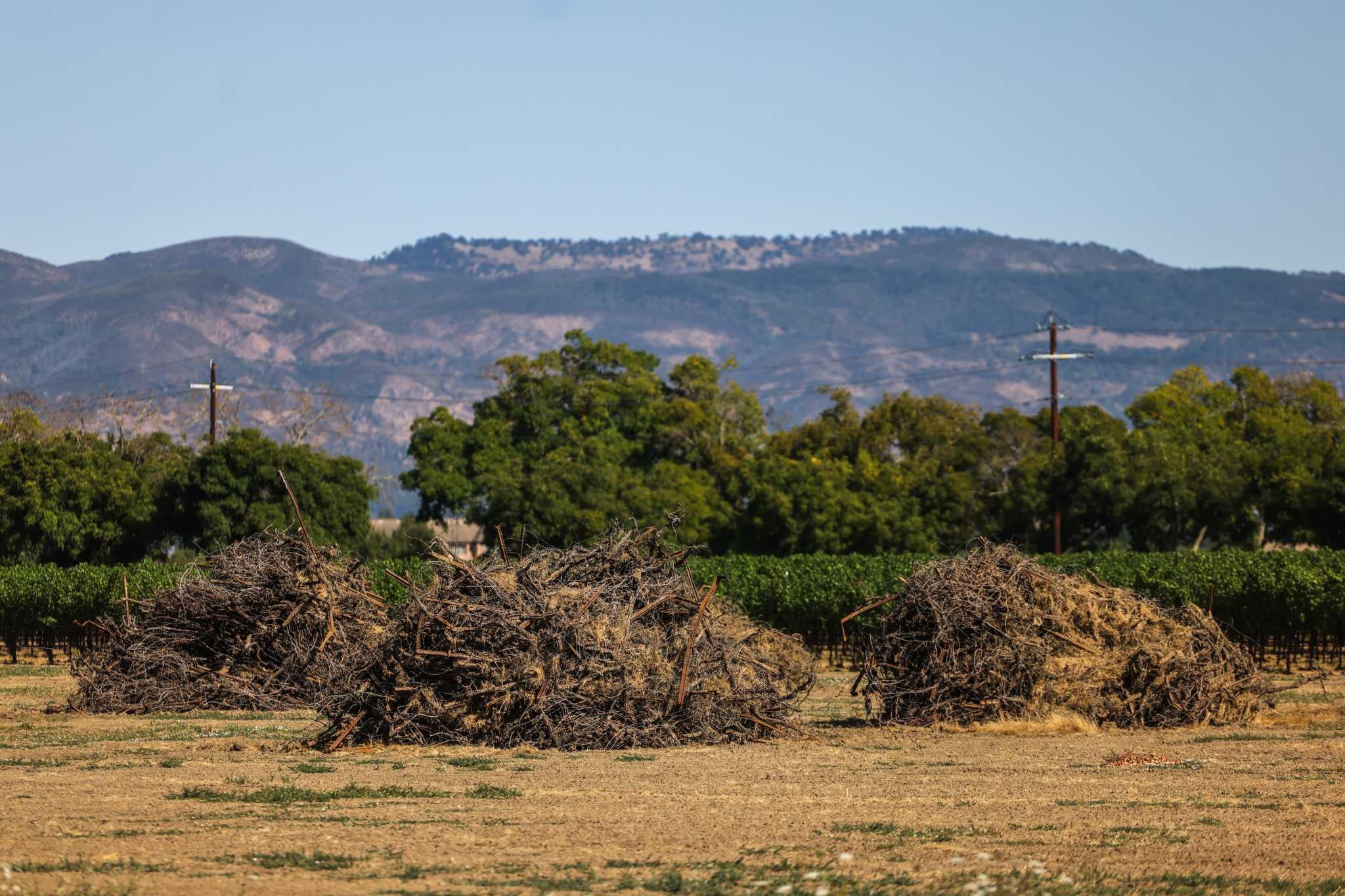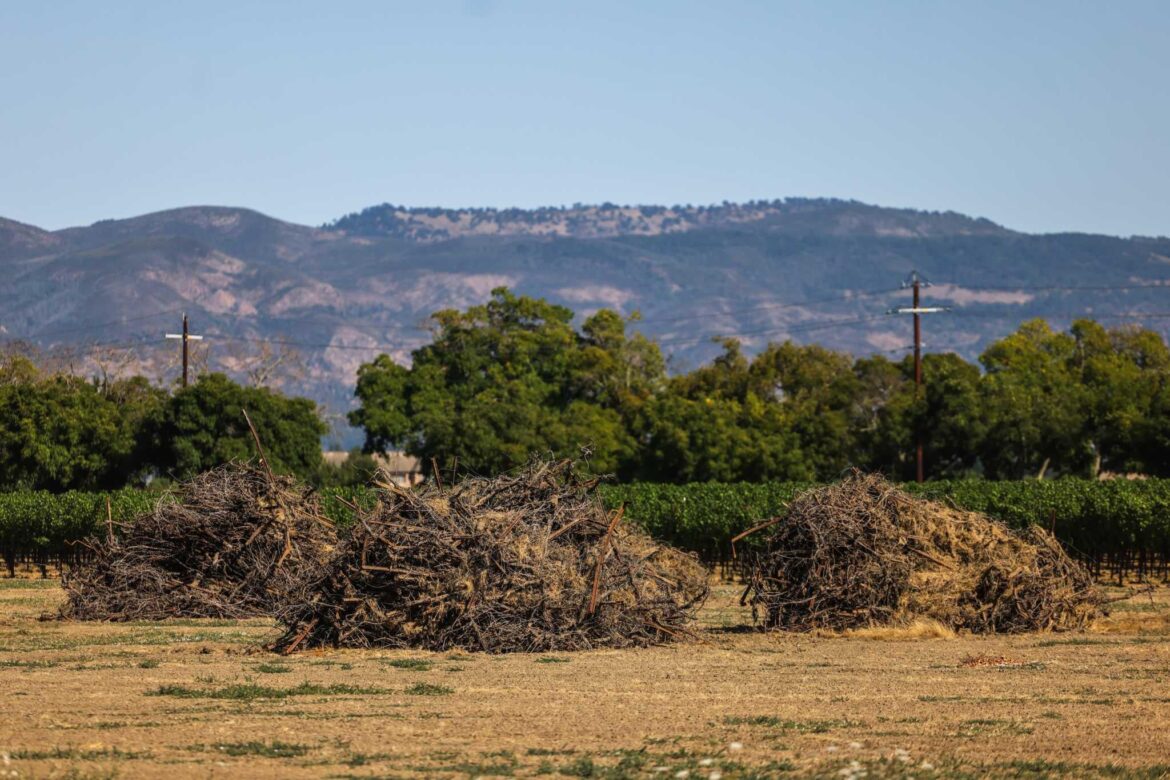
Driving on Napa Valley’s Highway 29 looks a little different this harvest. Dirt fields have supplanted many of the region’s prized vineyards. Menacing piles of dead vines sit atop the fallow ground, stripped of the chance to produce wine ever again.
The scene paints a somber picture of the wine industry’s foremost struggles: Alcohol consumption has hit a 90-year low and there’s a major oversupply of wine and grapes. Tens of thousands of acres of vineyards have been ripped out across the state, and despite mostly ideal weather conditions this growing season, more than 100,000 tons of California wine grapes will likely be left on the vines to rot — for the second consecutive year.
“We’re living in two worlds right now,” said Stuart Spencer, executive director of the Lodi Winegrape Commission. “This is some of the best-looking Zinfandel we’ve had in years. I’m optimistic from a quality perspective, but the broader market conditions are driving everything down.”
Advertisement
Article continues below this ad
In 2024, California wine experienced its lightest harvest in 20 years — a 23% decrease from 2023 — as many California wine growers failed to find buyers for their crop. Some slashed their prices by more than 50% in an attempt to cover a small portion of their farming costs. Industry experts estimated that between 100,000 and 400,000 tons of grapes went unharvested, and 35,000 to 40,000 acres of vines were ripped out.
This year, the situation is “not any better,” Spencer said, “and could be worse.” He estimated that roughly 15,000 to 20,000 acres of Lodi vines have been ripped out in the past few years, resulting in a 15%-20% decline in total acreage. Jeff Bitter, the president of Allied Grape Growers, a cooperative that represents around 400 growers in California, projects that another 35,000 to 40,000 acres of vines will be removed this year, and noted another recent development: tens of thousands of acres of vineyards have been abandoned.
“That wasn’t the case in 2024,” Bitter said. “There’s nothing that has improved between 2024 and 2025.”
Many California wine growers are ripping out vines this year.
Many California wine growers are ripping out vines this year.
Gabrielle Lurie/S.F. Chronicle
The abandoned vineyards are a sign that many California grape growers have reached their breaking point. That’s the case for Jason Smith, a second-generation grapegrower in Monterey County, who decided to shut down his business after more than 50 years. At its peak, Smith’s vineyard management company, Valley Farm Management, had 50 full-time employees and farmed roughly 3,200 acres of grapes — 2,500 of which his family owned. But about five years ago, after two decades of solid growth, the market began to shift.
Advertisement
Article continues below this ad
In 2024, Smith said 90% of his grapes were under contract, and while he took a loss, “it wasn’t a nightmare.” But heading into 2025, only 40% of his fruit was under contract. No one was looking to buy, he said, and any offers would likely be $500-$1,000 under what it costs to farm per ton. Without contracts, the banks wouldn’t give him the loans he depends on each year to cover his farming costs ahead of harvest. “It became a quick reality,” Smith said, “like, holy cow, if I don’t make some hard decisions, we could go bankrupt.”
Smith decided that the 2025 harvest would be his last. He’s down to a single, 106-acre vineyard. “We will not be in the industry come January,” he said. “Do I want to do this? No. This was our family business, our family legacy. It’s very emotional, but the bottom line is the bottom line.”
Monterey County and Lodi have struggled more than most wine regions, but the crisis has even infiltrated California wine’s crown jewels.
Last year was “better than expected,” said Sonoma County Winegrowers president and CEO Karissa Kruse, but “it’s definitely trickled down” this year.
The Sonoma County Winegrowers have projected that roughly 10% of the region’s vineyard acreage will be pulled out this year, totaling about 5,000 acres. Two thousand of those acres are unlikely to be replanted, said Kruse, as the growers did not obtain replant permits. The organization also projects that 30% of the region’s wine grapes won’t be contracted this year. Those grapes will either be purchased later in the season (likely at a steep discount), left on the vine or made into bulk wine, which sells for significantly less than grapes. Moreover, Kruse said the Winegrowers foresee a 7% drop in grape prices.
Advertisement
Article continues below this ad
In Napa Valley, “there has been a decent amount of vineyard removal since last harvest,” said Caleb Mosley, the executive director of the Napa Valley Grapegrowers. He didn’t provide an estimate of how many acres have been pulled in the region, but said some growers don’t have plans to replant. Mosley added that some vineyard owners are using the downturn as an opportunity to pull out old and diseased vines. Red blotch, a devastating and complex grape vine disease, has surfaced in many of Napa Valley’s vineyards in recent years; removing the vines, Mosley said, is “a great way to prevent insect movement.”
Churned dirt that would normally be growing grapes is seen off of Highway 29 in Napa.
Churned dirt that would normally be growing grapes is seen off of Highway 29 in Napa.
Gabrielle Lurie/S.F. Chronicle
It’s early in the harvest season, but Natalie Collins, president of the California Association of Winegrape Growers, said thus far, there hasn’t been “really any movement” on the grape market where uncontracted grapes are sold, even with popular grape varieties like Chardonnay. In an August report, wine and grape brokerage firm Ciatti called the market “stubbornly sluggish,” and Wine Business reported that listings for grapes and bulk wine sales on its website have hit a new high this year. Total listings through June were up 2% from last year and nearly 60% from 2023.
“A lot of the smaller producers that (typically) pay better pricing have cut back, too,” said Spencer. “It feels like we’re bouncing along the bottom and waiting for some sort of good news.”
Some farmers were hopeful that President Trump’s tariffs on European goods could help with one of the biggest contributors to the oversupply issue: cheap bulk wine imports. But the tariffs aren’t large enough to push large U.S. wine companies to buy from domestic producers, Collins said, and 2025 bulk wine imports were up 17% through June, according to a report from wine industry data analyst Gomberg, Fredrickson & Associates. “The price gap is still too big,” she said. “It would have to be a 50%-150% (tariff) to make an impact.”
Advertisement
Article continues below this ad
Canada’s ban on U.S. alcohol, a retaliatory move to the Trump administration’s tariffs, has been another blow to the California wine industry. But last week, Canada agreed to remove its 25% retaliatory tariff on U.S. wine. If the country’s provinces also decide to allow U.S. alcohol back on their shelves, some California producers may choose to purchase extra grapes to export wine there.
Wildfires could create some minor demand, too, Collins said, as wineries with smoke-tainted grapes might look to purchase replacement fruit. The August Pickett Fire in the eastern hills of Napa County damaged roughly 1,500 acres — over 3% of the region’s vineyard acreage — according to Napa County’s preliminary damage assessment survey. Twenty percent of the surveyed producers reported fire or heat damage, and 80% reported potential smoke effects. Meanwhile, the impact on the grape crop from the 130,000-acre Gifford Fire in the Central Coast is still being determined.
Yet neither wildfires nor Canada is likely to break open the grape market’s floodgates. Bitter predicts it will require a 2025 grape harvest of just 2.5 million tons or less — last year’s was 2.8 million — to correct the oversupply.
“The answer,” he said, “is to produce less until we’re in balance.”
by FatherEsmoquin


9 Comments
This is pretty much what everyone expected going into this year. The demand hasn’t increased and discretionary spending sure hasn’t either.
California has too much wine for sale compared to demand and the QPR for Cali wine was never great to begin with
What I think is the real issue is California wine has gotten way too greedy and the majority of it is pretty low quality. You used to be able to find a somewhat decent bottle in the $20-$30 range now you really have to get up to $50 or so. I’ve fallen off so many lists and prices doubled in the last five years and tasting fees ballooned up to $50-$75 a person.
I didn’t expect this even being an industry professional, Our sales have been growing significantly and everyone else has been saying sales are down and I’ve experienced the opposite personally always thought it was just people doom and glooming cause they just like to complain.
Glad to finally see this. One problem is the decline in alcohol consumption. My main beef with California wine is, at least for my palate, I can’t go to a store and pick up a California wine and know what to expect, esp. at a lower price point. Many of the wines taste like added chemicals, they’re too big, too sweet, and lack acidity. Sure I can spend hours doing research to find that unicorn of terroir-driven wine but why would I?
The Chronicle likes to publish the sky is falling articles to get more clicks. Not like they’re the only ones.
Concerning vines being pulled out, a key piece is where it was mentioned 5000 acres being pulled out and 2000 of those not likely to be replaced. Vines get pulled out for many reasons. Sometimes they get replaced.
On the other hand, I’m seeing ads on my social media from people trying to sell grapes from this year’s harvest, something I’ve never seen.
There is definitely contraction going on in the industry. How much and for how long is unknown. This has happened before and the industry has usually come out bigger and stronger afterwards. No guarantee it will this time, of course, but trying to put the final nail in the coffin for Napa is BS. BTW Napa is 4% of the state’s wine.
To talk about California suffering and paint some dramatic picture of Napa being decimated, while discussing all of the Lodi fruit and vines being left behind is truly hilarious and on brand for the chronicle.
A bad year for growers is a good year for winemakers who buy grapes on the market and/or don’t their own vineyards, whether it’s small winemakers all over California or big companies like Costco and Trader Joe’s that have historically taken advantage of this kind of situation to contract produce good to premium quality wine at comparatively inexpensive prices. Gluts are generally good for consumers
35,000 to 40,000 acres of vines were ripped out.
Holy Shit that’s a Lot of wine that’s gone. But hey free market. If people wanted it, they would buy it
South Monterey County and Lodi were producing a lot of grapes that are grown specifically for the bulk wine market.